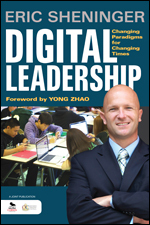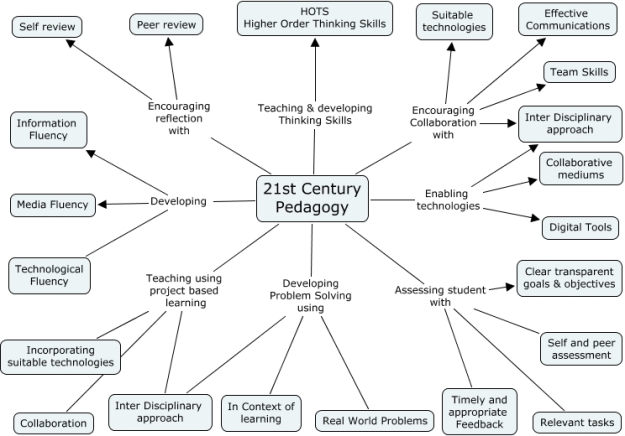From: http://www.corwin.com/books/Book240618/ reviews#tabview=title
“The most important aspect of digital leadership is establishing a vision and a strategic plan for increasing authentic engagement of students in the teaching and learning process” ~ Sheninger, Jan. 2014
So… I just finished reading Eric Sheninger‘s new book – Digital Leadership: Changing Paradigms for Changing Times. I also learned a new word. Heutagogical
Here’s my conundrum: So often I feel that there’s this huge divide between those who are ‘on-board’ with digital literacy and leadership, supporting innovative education with passion and creativity, and those educators who are still pretty much stuck in the good ole days! I’m excited and honored to be connected to so many like-minded, 21st century focused educators but I feel like we often write about and promote ideas that are basically preaching to the choir. We read each others’ posts and share them/like them… It’s the educators who aren’t yet in the choir that we somehow need to connect to. How can we best do that!?
Sheninger does a great job of providing a plan for those who aren’t yet ‘connected’ to take those steps forward to become a digital leader. I have no doubt that many like-minded educators will greatly enjoy Digital Leadership. Hopefully, by reading this book, talking about this book and recommending it to others the ideas will spread.
So… the book. It provides a solid rationale for schools to start transforming into 21st century learning organizations. Sheninger lays out a very clear plan, with specific examples, for those who are just starting out to really embrace digital leadership. As Yong Zhao puts it, in the Foreword, “A framework for leading educational transformation with technology.” I was especially interested in his brief discussions of Web 3.0. Sheninger really pulls from all the current 21st century education thought leaders (Yong Zhao, Andrew Churches, Alec Couros, George Couros, Bill Ferriter and many more) as well as more traditional but still current educational leadership thought leaders like Michael Fullan and others.
There are so many wonderful points that Sheninger hits (the following are in no way a comprehensive list!):
- The world has changed… and so must schools!
- The array of digital tools available to schools to enhance learning, increase engagement, connect globally and communicate more effectively is enormous (Interactive White Boards. Chromebooks, Tablets, Web 2.0 apps [like Facebook, Twitter, Skype, Prezi, Wikis, Animoto, etc.], Video Conferencing software, OpenCourseWare, Massive Open Online Courses, Gaming, etc.)
- The concept of space (virtual or physical) is the entry point for instructional change… AS LONG AS THE TEACHERS ARE EMBRACING LEARNING FOR TODAY AND TOMORROW!
- Support and PD for teachers is ESSENTIAL… empower, articulate the why and how focused on improving learning, build capacity, use data and share it transparently… and, acknowledge the potential roadblocks.
- Digital leaders model the vision… once you use the technology you can become an advocate for it.
- Communication, Communication, Communication… connected to Branding, Strategic Partnerships and Public Relations (he hits Branding/PR and Strategic Partnership building very well and often!)
- The “Pillars of Digital Leadership”: Communication; PR; Branding; Professional growth and development; Student Engagement/Learning; Opportunity; and, Learning Environment and Spaces are all aligned to the ISTE NETS-A AND the Breaking Ranks Framework.
Here’s a couple more of my favorite quotes from the book:
“Technology can engage, connect, empower, and enhance teaching, how educators learn, the work done by schools, and stakeholder relations” p.45
…”Leaders become the epicenter of their learning and determine what, where, and when they want to learn… Connectedness and control of learning provides leaders with the ability to determine their own path and to differentiate to meet their diverse learning needs”. p.122
Here’s some of the many references he makes:
- Michael Fullan’s Six Secrets of Change
- NASSP’s “Breaking Ranks: 10 Skills for Successful School Leaders“
- NASSP “School Improvement” page
- International Society for Technology in Education – Standards for Administrators
- ZippSlip for paperless form processing
- Anytime PD
- eDidaktik.dk to assess suitability of digital tools
- Independent OpenCourseware Studies
- OpenCourseWare Scholar (very cool!)
- “Becoming a Digital School Leader” course available through iTunes… he mentioned this one. I couldn’t find it but I found so many other very useful, free courses (I used to use an open Harvard ethics course to teach a pre-TOK/Philosophy course… very useful!)
- Integrating Digital Tools and Content to Develop Essential Literacies (immediately useful and practical – from PBS. LOTS of great stuff there!)
What I didn’t like so much: Not really addressing the issue of the growing divide between the ‘haves’ and the ‘have nots’. Basically, Sheninger said to not let that be an excuse to not take the steps to transform. I would agree with that but I would also like to see creative suggestions on how to deal with making the divide less pronounced. That said, within each school’s individual context there are ways to balance resources in a fair (but not equal) way that must be done with sensitivity and confidentiality. Sheninger gave the example of a laptop cart with less than a full class set of laptops that is used to supplement for those who don’t have a laptop.
Basically, there’s a lot to like, a lot to reflect on and a lot to walk away with and immediately put to use.



It is nice to see that you are so aware of what needs to happen in not only providing a good educational structure as well as focusing on equality so that students will come away with feeling that they are just as important as the student he/she is sitting next to.
I wish all educators could see this as an important
undertaking.